
Concept explainers
(a)
Interpretation:
The products expected when
Concept introduction:
An
All these reactions take place in the presence of basic compounds but in case of
Answer to Problem 9.45AP
The products formed when

Explanation of Solution
The type of reactions those occurs when
The products that are obtained via

Figure 1
The
An
The products formed when
(b)
Interpretation:
The products expected when
Concept introduction:
An alkyl halide in the presence of basic compounds undergoes multiple kinds of reaction, for example,
All these reactions take place in the presence of basic compounds but in case of
Answer to Problem 9.45AP
The products expected when

Explanation of Solution
The type of reactions which
The products that are obtained via

Figure 2
The
An
The products expected when
(c)
Interpretation:
The products expected when
Concept introduction:
An alkyl halide in the presence of basic compounds undergoes multiple kinds of reaction, for example,
All these reactions take place in the presence of basic compounds but in case of
Answer to Problem 9.45AP
The product expected when
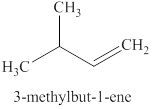
Explanation of Solution
The type of reaction which
The product that is obtained via

Figure 3
An
Only
The product expected when
(d)
Interpretation:
The products expected from the reaction of the product of part (c) and
Concept introduction:
An
Answer to Problem 9.45AP
The products expected from the reaction of the products of part (c) and
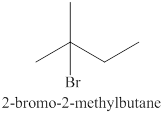
Explanation of Solution
Markonikov’s gave the rule purely on the basis of the observation of products received by him when performed the addition reaction on alkene.
Some reactions do not follow the rule because they follow the stability of the intermediate formed in the mechanism of that particular reaction.
The reaction of an alkene
In the reaction between the product of part (c) and
The products expected from the reaction of the products of part (c) and

Figure 4
The products expected from the reaction of the products of part (c) and
(e)
Interpretation:
The products expected when
Concept introduction:
An alkyl halide in the presence of basic compounds undergoes multiple kinds of reaction, for example,
All these reactions take place in the presence of basic compounds but in case of
Answer to Problem 9.45AP
The products expected when
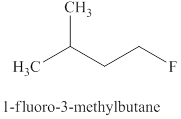
Explanation of Solution
The type of reaction which
The product for the

Figure 5
The
The fluoride ion only undergoes
The products expected when
(f)
Interpretation:
The products expected from the reaction of the product of part (c), chloroform and potassium
Concept introduction:
Answer to Problem 9.45AP
The products expected from the reaction of the product of part (c), chloroform, and potassium
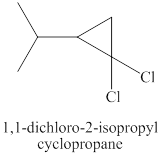
Explanation of Solution
Step-1: Take up of proton to give carbanion.

Figure 6
Step-2: Elimination of chloride ion to give carbene.
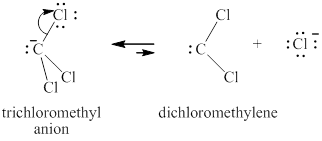
Figure 7
The carbene thus formed adds on the alkene in the leading to no change in the respective stereochemistry of substituents on alkene.
The same reaction is happening when the product of part (c) plus chloroform plus potassium
Therefore, the products expected from the reaction of the product of part (c), chloroform and potassium
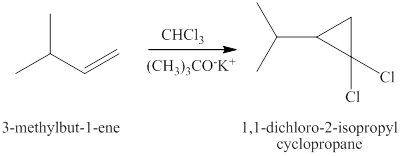
Figure 8
The products expected from the reaction of the product of part (c) chloroform and potassium
(g)
Interpretation:
The products expected from the reaction of the product of part (c) and
Concept introduction:
The reaction of an alkene with the diiodomethane in the presence of
Answer to Problem 9.45AP
The products expected from the reaction of the product of part (c) and
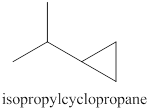
Explanation of Solution
The reaction of the product of part (c) and
The products expected from the reaction of the product of part (c) and

Figure 9
The products expected from the reaction of the product of part (c) and
(h)
Interpretation:
The products expected from the reaction of
Concept introduction:
The reaction of an alkyl halide with a metal like lithium leads to the formation of organolithium compounds (alkyllithium). These compounds are very sensitive to moisture or polar hydrogens reacts immediately leading to the formation of
Answer to Problem 9.45AP
The products expected from the reaction of
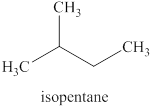
Explanation of Solution
The reaction of an alkyl halide with a metal like lithium leads to the formation of organolithium compounds (alkyllithium), which are highly susceptible to humidity or react to polar hydrogen instantly leading to the alkyl group’s formation. The same reaction is happening in this case.
The products expected from the reaction of

Figure 10
The products expected from the reaction of
(i)
Interpretation:
The products expected when
Concept introduction:
An alkyl halide in the presence of basic compounds undergoes multiple kinds of reaction, for example,
All these reactions take place in the presence of basic compounds but in case of
Answer to Problem 9.45AP
The products expected when

Explanation of Solution
The type of reactions that occurs when
The products that are obtained via

Figure 11
The
An
The products expected when
(j)
Interpretation:
The products expected from the reaction of
Concept introduction:
The reaction of an alkyl halide with a metal like magnesium in the presence of dry ether leads to the formation of
Answer to Problem 9.45AP
The products expected from the reaction of

Explanation of Solution
The reaction of an alkyl halide with a metal like magnesium in the presence of dry ether results in the formation of (organometallic compounds) also known as a Grignard reagent. These compounds are very susceptible to reactions of moisture or polar hydrogen leading to the creation of alkane of the alkyl group instantly. In this case, the same reaction is occurring.
The Grignard reagent obtained in this reaction is isopentylmagnesium bromide and product obtained after treatement with heavy water is deuterated isopentane.
The products expected from the reaction of

Figure 12
The products expected from the reaction of
Want to see more full solutions like this?
Chapter 9 Solutions
EBK ORGANIC CHEMISTRY STUDY GUIDE AND S
- For each reaction below, decide if the first stable organic product that forms in solution will create a new CC bond, and check the appropriate box. Next, for each reaction to which you answered "Yes" to in the table, draw this product in the drawing area below. Note for advanced students: for this problem, don't worry if you think this product will continue to react under the current conditions - just focus on the first stable product you expect to form in solution. དྲ。 ✗MgBr ? O CI Will the first product that forms in this reaction create a new C-C bond? Yes No • ? Will the first product that forms in this reaction create a new CC bond? Yes No × : ☐ Xarrow_forwardPredict the major products of this organic reaction: OH NaBH4 H ? CH3OH Note: be sure you use dash and wedge bonds when necessary, for example to distinguish between major products with different stereochemistry. Click and drag to start drawing a structure. ☐ : Sarrow_forwardPredict the major products of this organic reaction: 1. LIAIHA 2. H₂O ? Note: be sure you use dash and wedge bonds when necessary, for example to distinguish between major products with different stereochemistry. Click and drag to start drawing a structure. X : ☐arrow_forward
- For each reaction below, decide if the first stable organic product that forms in solution will create a new C - C bond, and check the appropriate box. Next, for each reaction to which you answered "Yes" to in the table, draw this product in the drawing area below. Note for advanced students: for this problem, don't worry if you think this product will continue to react under the current conditions - just focus on the first stable product you expect to form in solution. NH2 tu ? ? OH Will the first product that forms in this reaction create a new CC bond? Yes No Will the first product that forms in this reaction create a new CC bond? Yes No C $ ©arrow_forwardAs the lead product manager at OrganometALEKS Industries, you are trying to decide if the following reaction will make a molecule with a new C-C bond as its major product: 1. MgCl ? 2. H₂O* If this reaction will work, draw the major organic product or products you would expect in the drawing area below. If there's more than one major product, you can draw them in any arrangement you like. Be sure you use wedge and dash bonds if necessary, for example to distinguish between major products with different stereochemistry. If the major products of this reaction won't have a new CC bond, just check the box under the drawing area and leave it blank. Click and drag to start drawing a structure. This reaction will not make a product with a new CC bond. G marrow_forwardIncluding activity coefficients, find [Hg22+] in saturated Hg2Br2 in 0.00100 M NH4 Ksp Hg2Br2 = 5.6×10-23.arrow_forward
- give example for the following(by equation) a. Converting a water insoluble compound to a soluble one. b. Diazotization reaction form diazonium salt c. coupling reaction of a diazonium salt d. indacator properties of MO e. Diazotization ( diazonium salt of bromobenzene)arrow_forward2-Propanone and ethyllithium are mixed and subsequently acid hydrolyzed. Draw and name the structures of the products.arrow_forward(Methanesulfinyl)methane is reacted with NaH, and then with acetophenone. Draw and name the structures of the products.arrow_forward
- 3-Oxo-butanenitrile and (E)-2-butenal are mixed with sodium ethoxide in ethanol. Draw and name the structures of the products.arrow_forwardWhat is the reason of the following(use equations if possible) a.) In MO preperation through diazotization: Addition of sodium nitrite in acidfied solution in order to form diazonium salt b.) in MO experiment: addition of sodium hydroxide solution in the last step to isolate the product MO. What is the color of MO at low pH c.) In MO experiment: addition of sodium hydroxide solution in the last step to isolate the product MO. What is the color of MO at pH 4.5 d.) Avoiding not cooling down the reaction mixture when preparing the diazonium salt e.) Cbvcarrow_forwardA 0.552-g sample of an unknown acid was dissolved in water to a total volume of 20.0 mL. This sample was titrated with 0.1103 M KOH. The equivalence point occurred at 29.42 mL base added. The pH of the solution at 10.0 mL base added was 3.72. Determine the molar mass of the acid. Determine the Ka of the acid.arrow_forward
 ChemistryChemistryISBN:9781305957404Author:Steven S. Zumdahl, Susan A. Zumdahl, Donald J. DeCostePublisher:Cengage Learning
ChemistryChemistryISBN:9781305957404Author:Steven S. Zumdahl, Susan A. Zumdahl, Donald J. DeCostePublisher:Cengage Learning ChemistryChemistryISBN:9781259911156Author:Raymond Chang Dr., Jason Overby ProfessorPublisher:McGraw-Hill Education
ChemistryChemistryISBN:9781259911156Author:Raymond Chang Dr., Jason Overby ProfessorPublisher:McGraw-Hill Education Principles of Instrumental AnalysisChemistryISBN:9781305577213Author:Douglas A. Skoog, F. James Holler, Stanley R. CrouchPublisher:Cengage Learning
Principles of Instrumental AnalysisChemistryISBN:9781305577213Author:Douglas A. Skoog, F. James Holler, Stanley R. CrouchPublisher:Cengage Learning Organic ChemistryChemistryISBN:9780078021558Author:Janice Gorzynski Smith Dr.Publisher:McGraw-Hill Education
Organic ChemistryChemistryISBN:9780078021558Author:Janice Gorzynski Smith Dr.Publisher:McGraw-Hill Education Chemistry: Principles and ReactionsChemistryISBN:9781305079373Author:William L. Masterton, Cecile N. HurleyPublisher:Cengage Learning
Chemistry: Principles and ReactionsChemistryISBN:9781305079373Author:William L. Masterton, Cecile N. HurleyPublisher:Cengage Learning Elementary Principles of Chemical Processes, Bind...ChemistryISBN:9781118431221Author:Richard M. Felder, Ronald W. Rousseau, Lisa G. BullardPublisher:WILEY
Elementary Principles of Chemical Processes, Bind...ChemistryISBN:9781118431221Author:Richard M. Felder, Ronald W. Rousseau, Lisa G. BullardPublisher:WILEY





